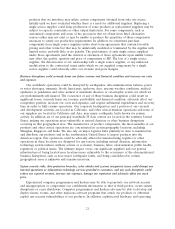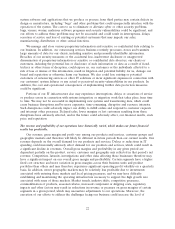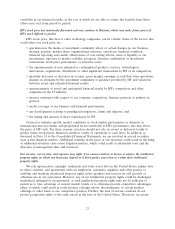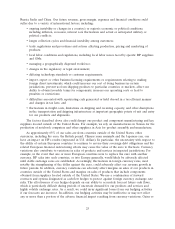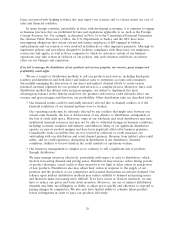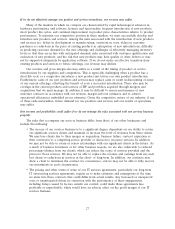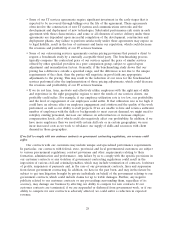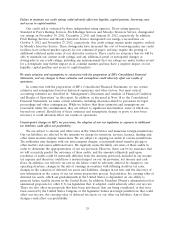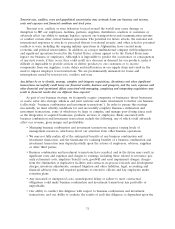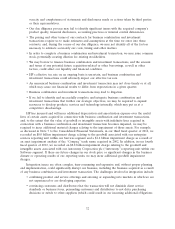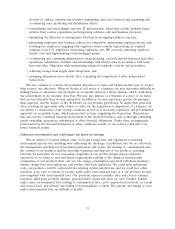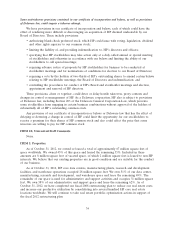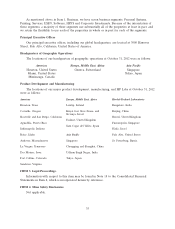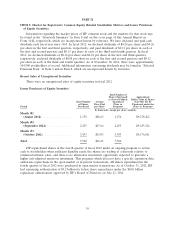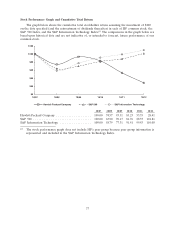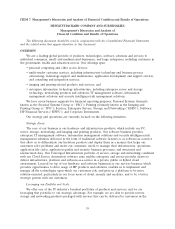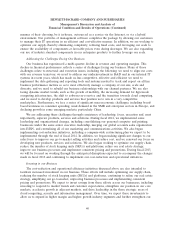HP 2012 Annual Report Download - page 38
Download and view the complete annual report
Please find page 38 of the 2012 HP annual report below. You can navigate through the pages in the report by either clicking on the pages listed below, or by using the keyword search tool below to find specific information within the annual report.Our sales cycle makes planning and inventory management difficult and future financial results less
predictable.
In some of our segments, our quarterly sales often have reflected a pattern in which a
disproportionate percentage of each quarter’s total sales occurs towards the end of such quarter. This
uneven sales pattern makes prediction of revenue, earnings, cash flow from operations and working
capital for each financial period difficult, increases the risk of unanticipated variations in quarterly
results and financial condition and places pressure on our inventory management and logistics systems.
If predicted demand is substantially greater than orders, there will be excess inventory. Alternatively, if
orders substantially exceed predicted demand, we may not be able to fulfill all of the orders received in
the last few weeks of each quarter. Other developments late in a quarter, such as a systems failure,
component pricing movements, component shortages or global logistics disruptions, could adversely
impact inventory levels and results of operations in a manner that is disproportionate to the number of
days in the quarter affected.
We experience some seasonal trends in the sale of our products that also may produce variations
in quarterly results and financial condition. For example, sales to governments (particularly sales to the
U.S. government) are often stronger in the third calendar quarter, consumer sales are often stronger in
the fourth calendar quarter, and many customers whose fiscal and calendar years are the same spend
their remaining capital budget authorizations in the fourth calendar quarter prior to new budget
constraints in the first calendar quarter of the following year. European sales are often weaker during
the summer months. Demand during the spring and early summer also may be adversely impacted by
market anticipation of seasonal trends. Moreover, to the extent that we introduce new products in
anticipation of seasonal demand trends, our discounting of existing products may adversely affect our
gross margin prior to or shortly after such product launches. Typically, our third fiscal quarter is our
weakest and our fourth fiscal quarter is our strongest. Many of the factors that create and affect
seasonal trends are beyond our control.
In order to be successful, we must attract, retain, train, motivate, develop and transition key employees, and
failure to do so could seriously harm us.
In order to be successful, we must attract, retain, train, motivate, develop and transition qualified
executives and other key employees, including those in managerial, technical, sales, marketing and IT
support positions. Identifying, developing internally or hiring externally, training and retaining qualified
executives, engineers, skilled solutions providers in the IT support business and qualified sales
representatives are critical to our future, and competition for experienced employees in the IT industry
can be intense. In order to attract and retain executives and other key employees in a competitive
marketplace, we must provide a competitive compensation package, including cash- and share-based
compensation. Our share-based incentive awards include stock options, restricted stock units and
performance-based restricted units, some of which contain conditions relating to HP’s stock price
performance and HP’s long-term financial performance that make the future value of those awards
uncertain. In addition, the value of all of our share-based incentive awards depends on HP’s stock
price, which declined by nearly 50% during fiscal 2012. If the anticipated value of such share-based
incentive awards does not materialize, if our share-based compensation otherwise ceases to be viewed
as a valuable benefit, if our total compensation package is not viewed as being competitive, or if we do
not obtain the shareholder approval needed to continue granting share-based incentive awards in the
amounts we believe are necessary, our ability to attract, retain, and motivate executives and key
employees could be weakened. The failure to successfully hire executives and key employees or the loss
of any executives and key employees could have a significant impact on our operations. Further,
changes in our management team may be disruptive to our business, and any failure to successfully
transition and assimilate key new hires or promoted employees could adversely affect our business and
results of operations.
30



